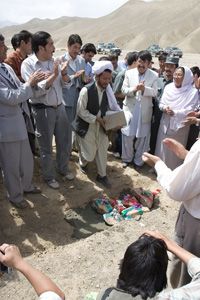Bamyan University
34°48′04″N 67°49′58″E / 34.801115°N 67.832813°E

Bamyan University (Persian: دانشگاه بامیان, Pashto: دبامیان پوهنتون, established approximately 1994[2] or 1997[3]) is a public university in Bamyan, central Afghanistan.
History[edit]
Pre-Taliban[edit]
Bamyan University was initiated around 1994 (another source indicates 1997) with the support of the Hazara political party Hezb-i-Wahdat. Before the Taliban takeover of the area, there were 400-500 male and female students at Bamyan University, under 40 professors.[2] In the mid-1990s, its facilities were simple, consisting of a few mud huts.[4]
Taliban era[edit]
The university was closed by the Taliban after their capture of the city of Bamyan in September 1998. Two buildings were stripped for scrap, while the third was used as a Taliban barracks and communications center. This third building was destroyed by U.S. airstrikes at the start of the war in Afghanistan in 2001.[2]
Islamic Republic of Afghanistan[edit]
Under the American and New Zealand Provincial Reconstruction Teams, the university was refurbished and reopened in 2004 with admission of 97 male and female students; the academic staff was 40 with a majority holding a master's degree.[5] Construction was, at one point, delayed due to the need to clear landmines, leading to student protests.[6] A number of Afghans who had taken refuge in Iran returned to Bamyan; of that group several female intellectuals became lecturers at the university.[7]
See also[edit]
References[edit]
- ^ The INL Beat (newsletter), November 2008, U.S. State Department Bureau of International Narcotics and Law Enforcement Affairs, Washington, DC
- ^ a b c Recknagel, Charles (2001-12-31). "Afghanistan: Dream Of Hazara University Destroyed By War (Part 2) - Radio Free Europe / Radio Liberty © 2011". Rferl.org. Retrieved 2011-02-13.
- ^ Rosemarie Skaine (2002). The Women of Afghanistan Under the Taliban. McFarland. pp. 83–. ISBN 978-0-7864-8174-3. Retrieved 24 August 2013.
- ^ Ahmed Rashid (2009). Descent Into Chaos: The U.S. and the Disaster in Pakistan, Afghanistan, and Central Asia. Penguin Books. pp. 199–. ISBN 978-0-670-01970-0. Retrieved 24 August 2013.
- ^ John Pike (2003-09-22). "Bamian". Globalsecurity.org. Retrieved 2011-02-13.
- ^ Dust in the Wind: Retracing Dharma Master Xuanzang's Western Pilgrimage. Rhythms Monthly. 2006. pp. 189–. ISBN 978-986-81419-8-8. Retrieved 24 August 2013.
- ^ Ghafour, Hamida (2004-07-22). "Bamiyan heals wounds left by the Taliban with a march for democracy". Telegraph. Retrieved 2011-02-13.

